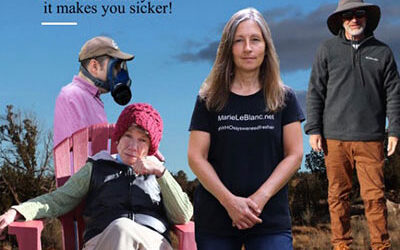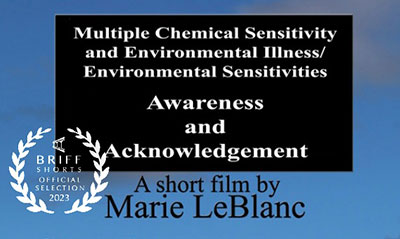 In the ME/CFS community, since yesterday, there has been a swell of jubilation. This may seem odd to a lot of people considering that researchers just found something in our blood similar to HIV. None of us are shocked by this news because we’ve always known we had something like HIV, something serious and deadly, but we have had to face a surreal social gaslighting while simultaneously weathering the horror of a terrible, life-destroying illness. Dr. Mark Loveless once said that an ME/CFS patient feels every day significantly the same as an AIDS patient feels two months before death. Now that statement holds more weight: ME is to AIDS what vegetative is to death.
In the ME/CFS community, since yesterday, there has been a swell of jubilation. This may seem odd to a lot of people considering that researchers just found something in our blood similar to HIV. None of us are shocked by this news because we’ve always known we had something like HIV, something serious and deadly, but we have had to face a surreal social gaslighting while simultaneously weathering the horror of a terrible, life-destroying illness. Dr. Mark Loveless once said that an ME/CFS patient feels every day significantly the same as an AIDS patient feels two months before death. Now that statement holds more weight: ME is to AIDS what vegetative is to death.
The discovery of a new retrovirus called XMRV in ME patients is the biggest news in the history of the ME epidemic (and yes, I’m fully claiming the term ME now, as all “CFS” patients can do, now that as Hilary Johnson says “Our Vietnam War Ended Today” and we can strip the shackles of this government’s attempts to squelch, misname, deny, and otherwise ignore our epidemic). News of the ME/XMRV connection has spread around the world like wildfire. Stories have appeared in just about every major media outlet. ME/CFS lists are buzzing. Patients who have written about our lives, screamed about these horrors, fought for medical attention, and died due to medical and social and governmental ignorance and suppression now have our day.
Along with all of the latest news stories, I think it’s a good time to revisit Neenyah Ostrom’s 1993 book America’s Biggest Cover-Up, which outlines fifty different physiological similarities between ME/CFS and AIDS. This book was published just a year after I came down with the “flu-like” (read: tsunami-like) illness that changed my life forever. When the “flu” hit, I was going through graduation proceedings at Oberlin College and then headed on a cross-country trip to San Francisco with my friend Jody and my partner Rachel. Jody and Rachel both still remember my surreal descent into a complex of symptoms so inexplicable I quickly felt like I was dying. While they were hiking the wilderness in New Mexico and Arizona, I was crumpled in the back of my car, dizzy and nauseous and light-sensitive and unsure if I would live. I was 23 years old.
Jody later wrote about this confusing descent for my disability hearing: “It was during the summer of 1992 that I first became aware of the severity of Peggy’s illness. I was moving out to San Francisco with Peggy and another friend, and we had decided it would be fun to take some time and drive across the country in two cars. So for almost two weeks we were together 24-hour days. Peggy was fairly incapacitated throughout the trip from a combination of headaches, nausea, and flu-like symptoms. At the time I think we chalked it up to an allergic reaction to something in the Southwest, and encouraged her to push herself to keep up. At some point during the trip it became clear to me that she wasn’t just being lazy or tired, but that she was physically unable to keep up and was already straining herself in a dangerous way.”
Once we arrived in San Francisco, in June of 1992, I faced a city that had been decimated by over a decade of economic struggle (that was the year Bill Clinton was elected after 12 years of Republican government) and AIDS. While AIDS had informed my whole sexual development, since I hit puberty almost exactly when it hit the public sphere, I was not prepared for the reality of AIDS in San Francisco. Fifty percent of the gay men in the city were said to be HIV-positive then. An air of overcompensation permeated the Castro, where it was somewhat rare to see men in wheelchairs with visible lesions, though they did appear briefly before disappearing altogether, perhaps on a last hoorah, sometimes pushed by other gay men who were obviously just cruising on the job, smiling and flirting with other men as they pushed a sickly, dew-eyed, emaciated man up that terrible hill.
I worked briefly at the top of that hill, at Castro and 19th. It was my first job after getting sick and I was far too ill to keep it, at a health food store. The HIV positive guy who hired me, upon looking at my resume that stated that my hometown was Normal, Illinois, joked “you could run for President too!” since of course Clinton was hyping his origins of Hope (Arkansas). Another HIV-positive guy who worked there called his illness “the hiv,” rhyming “hiv” with “give.” Those guys were much more healthy than I was, as were most of the HIV-positive men who came into the store with special discount cards they got for being HIV-positive. They used these cards to buy weight gain powder, and other supplements that I noticed carefully, often buying the same ones after they left.
I could barely stand up. In fact, being upright had become almost impossible due to increasing dysautonomia, so having a job that required standing for eight hours at a time was not something I could continue. I somehow made it through a little over a month there, working only four days a week with chest pains and flu-like symptoms and a skyrocketing heart rate, and sleeping most of the rest of the time. During that month, I saw my first ME/CFS doctor, who was actually a well-known AIDS specialist — Jon Kaiser, MD. I had gotten his name thanks to a brochure for the CFIDS Foundation that had been sitting in Lyon-Martin Health Center when I went there right after realizing I was too sick to go on, a few weeks after my arrival in San Francisco. Interestingly, Lyon-Martin had been associated with an earlier ME/CFS cluster outbreak — which I did not learn until reading Osler’s Web — but the only residue of that outbreak was this little brochure in the entryway. The doctor at Lyon-Martin was useless: she told me that I would be better in a few weeks and should come back for a Pap smear.
Dr. Kaiser, the AIDS doctor, did not diagnose me with ME/CFS — he ran up lots of expensive tests I could not afford and bankrupted me, then tried to sell me affirmation tapes. I didn’t know at the time that the CDC required patients to be symptomatic for six months or more for an official diagnosis. Dr. Kaiser wrote that I had “fatigue and chronic pharyngitis” in my chart, but interestingly did prescribe me his typical regimen for immunocompromised ME/CFS and AIDS patients. Perhaps most notable about this was the fact that he gave ME/CFS and AIDS patients most of the same supplements. They were the ones the HIV-positive guys bought at the store, such as this product called Resist. I was careful to buy mine (using my employee discount) when nobody else in the store was watching, lest they think I was hiding a secret HIV status. I could not afford to see Dr. Kaiser more than a couple of times, and then spent the next two and a half years in diagnostic limbo until finally getting diagnosed with ME/CFS by a Harvard-trained infectious disease specialist (who also saw a lot of AIDS patients) on the East Coast. That was in 1995, right before I went on disability and my work days were over for good.
I was very aware then that I had something AIDS-like, but had tested negative on HIV tests — and I had had two of them over the course of a year just to be sure (my college was known for bisexual experimentation of all genders). My jobs after the health food store did not help me avoid the reality of AIDS: it was always, in San Francisco pre-cocktail drugs, in everyone’s face. At the same time, as a 20-something, I didn’t relate to the stories of loss told constantly by the 30-somethings and 40-somethings who had lived in the city for years and lost most of their friends. I just knew I was deathly ill too, and there was no place for me — no place for people who had non-AIDS. In my two and a half years in San Francisco, while I struggled to make income despite being too sick to work at all, I worked with others who had been touched by AIDS. One job was for an HIV-positive psychotherapist who led support groups for HIV-positive men focusing on survival strategies. He paid me to do library research to compile a bibliography on all that had been written about the characteristics of long-term survivors of HIV and AIDS. He lived in a gorgeous, open, lonely-seeming apartment, where I remember seeing a stack of humorous ‘zines titled “Diseased Pariah” on a ladder that seemed to go nowhere.
I also worked for a blind writer who had lost her beloved son to AIDS. Her son’s wife had also died of AIDS, and the writer — then in her 80s — had stepped in to raise her orphaned granddaughter just as her blindness was developing. It was a remarkable story that she was too traumatized to tell the whole time I worked with her — I learned the story from the gay guy who had hired me for the job, and later from an oral history tape the writer had given me to transcribe. A fascinating former radical who told me she had once had a run-in with the McCarthy committee, the writer lived on Haight street, perched in the third-floor apartment that she rarely seemed to escape. There, not far from the once-explosive Haight-Ashbury district where so many radical politics and arts were forged, blind and tamped with grief and left with only a paper menu from her son’s old restaurant, she seemed emblematic of all that had gone wrong with the idealistic city of San Francisco.
I tried to hide from all of them how sick I was, because I had quickly learned that admitting illness in San Francisco would limit job opportunities. But I also sensed — and perhaps I was wrong — that they knew I was one of them, touched somehow by AIDS but not in the way they thought. I could tell that they sensed the gripping fear at the edge of my frailty, that perhaps they noticed how quickly I was losing weight, or the pallor in my cheeks. The writer, despite being blind, seemed to see right through everyone, and I found myself using body language that blocked her off when I was with her, so afraid she would do a third eye penetration of the truth that I was hiding. She was sad and a little angry when I moved away, so heavy already with loss, and I still wonder now if she knew what I didn’t know then — that I would never be well enough to return to San Francisco and would not see her again before she died.
After that, in Providence, I briefly taught a writing workshop out of my apartment for people living with chronic illness. One participant with a teenager with AIDS, whose story was absolutely wrenching and it seemed like he would not live to see his twenties. A couple of years later, I ran into him — after the dispersion of the AIDS cocktail drugs. He was elated, about to travel to San Francisco — his T-cells were great, his viral load was almost nonexistent now. How was I? he asked. I gently told him how my health was plummeting.
What is utterly mind-blowing to me now was how much the writings in those early days of my illness reflected an awareness of the ME/CFS-AIDS connection, and yet the research on retroviruses was, at the time, sidelined in favor of other avenues. I wrote in the Introduction to my book Stricken: Voices from the Hidden Epidemic of Chronic Fatigue Syndrome about the SPECT scan research published by Dr. Anthony Komaroff and his colleagues in 1994, in which he compared SPECT scans of ME/CFS patients to those of people with unipolar depression, AIDS dementia, and a control group — and ME/CFS brain scans looked almost identical to those of patients with AIDS dementia.
Perhaps most astonishing to me now is this quote I read in Ostrom’s book, in which she talks about Dr. Paul Cheney’s observations at the time about his ME/CFS patients who were dying of opportunistic, AIDS-like infections:
“Dr. Cheney described the immune system damage seen in CFS patients for the Food and Drug Administration in May 1993. Dr. Cheney told the FDA that five of his CFS patients had died during the preceding six months. Two of these patients committed suicide, which is all too common among CFS patients. But three of Dr. Cheney’s patients who died, like AIDS patients, succumbed to overwhelming infections that their damaged immune systems couldn’t fight off. But Dr. Cheney’s CFS patients, like the ICL patients [those with HIV-negative, AIDS-like disease], appeared not to be infected with HIV, even though they developed AIDS-like immunodeficiencies and, in some cases, life-threatening opportunistic infections.”
I have spent the last five years nearly dying from opportunistic infections, including a bartonella infection that took an AIDS-like course in my body and produced rampant cardiac and neurological damage, so this quote rings heavily for me. I have been in ME/CFS hell for seventeen years, and in the past five it has become more and more harrowing as I have flirted increasingly with death, particularly over the past year (I have finally recovered enough to write this blog post — barely). I have become — and hopefully will be well enough to write more about this at some point — like the other patients who are dying or have died, and who look exactly like AIDS patients. It would be hard to look at pictures of some of my wasting ME/CFS friends and deny the ME/CFS-AIDS connection. Yet as I pleaded with an idiot doctor as I was dying of a heart infection from bartonella, begging him for antibiotics, and moreover showing him articles about the behavior of bartonella infections in HIV-positive patients to explain why I was so sick, he ignored me until I almost died.
Now, on his current blog, Dr. Cheney is taking a more understated approach than he did in the early ’90s, but his statements seem to imply that bartonella — as a common coinfection of Lyme — may be just another opportunistic infection that attacks ME/CFS patients because of a retrovirus-damaged immune system. “I have not really seen what I would call a pure Lyme case but many with CFS and a positive Igenex WB assay and antibiotic failure for chronic Lyme,” writes Cheney about the XMRV virus discovery.
Dr. Cheney may seem nonplussed by this new discovery since he has witnessed these connections all along. As I wrote about the ME/CFS-AIDS connections in my essay “The Paradox of Lost Fingerprints” in Stricken:
“It cannot be underestimated how much AIDS politics both eclipsed and influenced the lives of CFIDS patients. Many writers have also pointed out bizarre and alarming connections between the two illnesses — such as similarities in brain scans and elevated HHV-6 titers. Dr. Paul Cheney, though, noticed what is perhaps the most remarkable correlative. When he entered data for 400 CFIDS patients into a computer, noting their time of onset and other factors, he found that CFIDS and AIDS cases have occurred — over time — at almost parallel rates of growth. But AIDS medical psychology also dramatically affected CFIDS patients. In the rhetoric of the AIDS years, people were taught to view illness as an outcome of behavior. Every illness in this era was shaped by the furor of AIDS politics. Even [Elaine] Showalter talked about CFIDS and Gulf War syndrome as ‘sickness lifestyles.’ This description was not unlike the homophobic AIDS rhetoric that confused gay ‘lifestyle’ with succeptibility. Once contagion was equated with behavior, and identity politics took over, pairing of illness and identity was almost inevitable. A strange contradiction emerged in this era when words such as ‘multiculturalism’ entered the public arena — the need to identify, along with the need to believe in the transcendence of inborn identity.” [117]
While AIDS patients got drug cocktails, ME/CFS patients got metaphors — often offensive, derisive, and soul-crushing metaphors. Those metaphors and the cruel cultural bullying around patients can certainly help explain the two patients Cheney mentioned who committed suicide: now we finally have an explanation for the other three who died of AIDS-like opportunistic infections. The patient-blaming approach can also be blamed for other deaths that weren’t suicides, such as the tragic death of Sophia Mirza who was forcibly sectioned to a psychiatric hospital for having severe ME and never recovered from her hospital stay, ultimately dying. As Ostrom wrote in 1993, ” Is it possible that a mistake has been made in formulating the definition of AIDS? Is Chronic Fatigue Syndrome actually part of the AIDS epidemic? If this is even a remote possibility, why haven’t other books been written about it? Why isn’t every health reporter in the country writing about it, every investigative reporter investigating? The answer, I believe, is pretty simple, and it is a problem that has dogged the AIDS epidemic since the beginning: denial.” I think we can now acknowledge that people like Mirza have died from this denial, and hopefully prevent more suffering and death.
At the first free medical clinic in America without a religious affiliation — the Haight-Ashbury Free Clinic — the motto “Health care is a right, not a privilege” was popularized, the year before I was born. It is not too late to actualize that motto for ME/CFS patients who have spent decades dealing with biased medical care. My blind writer friend on Haight Street said it best to me when she told me how much she hated the parable of the blind men and the elephant. She felt like that parable was an insult to the blind, who actually cultivate their senses, who look further to see the elephant that was there all along. She made it seem so simple, to cultivate awareness of the obvious, to deal with exactly what is there. Hopefully the medical establishment will listen now, to this retroviral elephant that can’t be ignored.









0 Comments